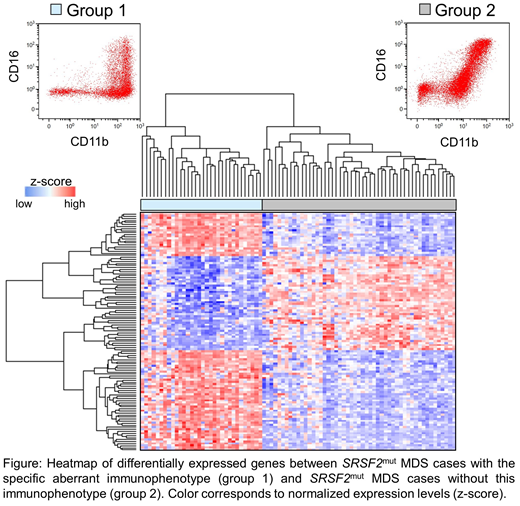Background: Myelodysplastic syndromes (MDS) comprise a heterogeneous group of diseases classified by comprehensive diagnostics. Identification of homogeneous subgroups is desirable to understand differences in clinical course and to develop targeted treatment approaches. We identified a specific immunophenotype in MDS and analyzed its genetic background.
Aim: To assess the genetic background of MDS with specific CD11b/CD16 expression pattern in granulocytes and reduced CD45 expression in myeloid progenitor cells (MPC) by whole genome (WGS) and whole transcriptome sequencing (WTS).
Methods: During routine flow cytometric evaluation for suspected MDS a specific immunophenotype was identified (Figure) which was found consistently associated with SRSF2 mutations. Normal granulocytic maturation starts with steep increase in CD11b expression paralleled by only slight increase of CD16 expression. This is followed by steep increase in CD16 expression paralleled by only slight further increase in CD11b expression (giraffe pattern). The immunophenotype newly identified in MDS patients is characterized by an increase of CD11b expression without CD16 expression followed by an increase in CD16 expression without further CD11b expression (rectangle pattern) and only dim CD45 expression of MPC.
32 such cases, all SRSF2mut (group 1) were selected to evaluate the molecular differences to 51 MDS SRSF2mut cases without this specific immunophenotype (group 2) by WGS and WTS. Variants were called with the Illumina tumor/unmatched normal workflow. A mixture of genomic DNA from multiple anonymous donors served as control sample. Variants with a global population frequency > 1% were removed and the final analysis was performed on protein-altering and splice-site variants only. For gene expression analysis, estimated gene counts were normalized and the resulting log2 counts per million were used as a proxy of gene expression in each sample. Unsupervised hierarchical clustering (HC) with Ward's method as clustering method and Euclidean distance as distance measure were used to segregate the patients according to their whole transcriptional profile. Analysis of differentially expressed (DE) genes was performed considering an adjusted p<0.05 and an absolute logFC>2 as significant.
Results: HC resulted in a dendrogram clearly showing two distinct clusters of samples consistent with groups 1 and 2 as defined based on the immunophenotype. 116 genes were DE, including 13 transcription factors (e.g. MYCN, ZNF462, HOXA10), 4 FDA approved drug targets (MMP2, PRLR, AR, MME) and 6 potential drug targets (AASS, PXDN, CYP27A1, SLC16A2, UCHL1, GUCY1A3) as indicated by the human protein atlas (Uhlén et al, 2015). The identified gene signature was significantly enriched for cellular developmental process, cell adhesion and extracellular matrix organization (adjusted p<0.05 for each pathway).
Analysis of the mutational profiles strikingly revealed that STAG2 mutations were exclusively found in group 1 (17/32, 53% vs. 0%, p<0.001). Hence, >50% of cases with the specific immunophenotype were characterized by co-mutations in SRSF2 and STAG2. STAG2 is a key member of the cohesion complex and its regulatory functions include chromosome segregation and formation of DNA loops that influence gene expression. Recently it was shown that the deletion of STAG2 severely impacts chromatin accessibility and cell fate decisions in hematopoiesis (Viny et al. 2019). Furthermore, group 1 was characterized by higher frequencies of mutations in ASXL1 (25/32, 78% vs. 9/51, 18%, p<0.001), NRAS (6/32, 19% vs. 3/51, 6%, p=0.07) and RUNX1 (11/32, 34% vs. 5/51, 10%, p=0.007). Of the 15 STAG2 unmutated cases from group 1, 6 (40%) had mutations in at least two genes out of ASXL1, NRAS and RUNX1. The same constellation was present in only 2/51 (4%) cases from group 2. Taken together, the immunophenotype of group 1, besides predicting SRSF2 mutations, is significantly associated with a specific mutation profile which is found in 23/32 (72%) such cases and which occurs infrequently in other SRSF2mut MDS cases (2/51, 4%, p<0.001).
Conclusions: We here for the first time describe a specific immunophenotype which defines MDS cases with SRSF2 mutations and a consistent and specific mutational and gene expression profile. This comprehensive data may qualify for the definition of a new sub-entity which should be addressed in future research.
Kern:MLL Munich Leukemia Laboratory: Employment, Equity Ownership. Walter:MLL Munich Leukemia Laboratory: Employment. Meggendorfer:MLL Munich Leukemia Laboratory: Employment. Baer:MLL Munich Leukemia Laboratory: Employment. Haferlach:MLL Munich Leukemia Laboratory: Employment, Equity Ownership. Haferlach:MLL Munich Leukemia Laboratory: Employment, Equity Ownership.
Author notes
Asterisk with author names denotes non-ASH members.


This feature is available to Subscribers Only
Sign In or Create an Account Close Modal